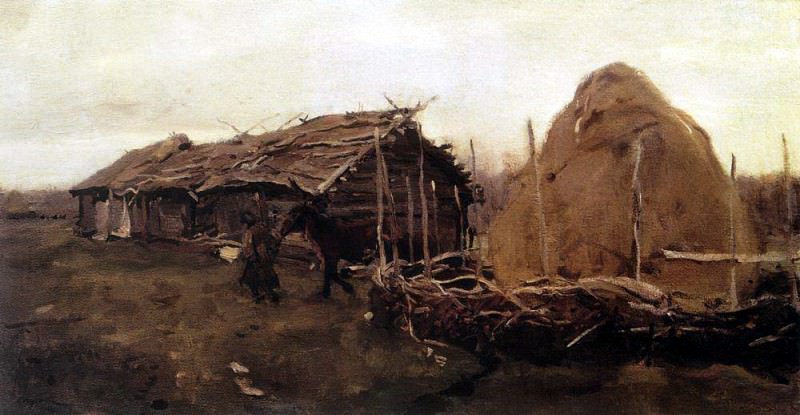haystack. 1901 Valentin Serov (1865-1911)
Valentin Serov – haystack. 1901
Edit attribution
Download full size: 1000×518 px (0,1 Mb)
Painter: Valentin Serov
In this painting we see a rural landscape. A large haystack is depicted in the foreground. It is probably a billet that the peasants made for the winter to feed their livestock. Around the hay we see a low fence, it seems as if it is not finished. The master has well drawn the weaving of this homemade fence - you can see almost every twig. Just a few meters from the haystack, a little behind, there is a ramshackle wooden structure.
Description of Valentin Serov’s painting "Haystack".
In this painting we see a rural landscape. A large haystack is depicted in the foreground. It is probably a billet that the peasants made for the winter to feed their livestock. Around the hay we see a low fence, it seems as if it is not finished. The master has well drawn the weaving of this homemade fence - you can see almost every twig.
Just a few meters from the haystack, a little behind, there is a ramshackle wooden structure. We can see that no one takes care of it: the wood is wet and the roof is leaning. The building does not look like a usual residential house. Most likely it was a farm building, a barn located in the field. Peasants could store their tools for plowing here.
To the left of the haystack we can see two figures - a man and a horse. It is immediately clear that we face an ordinary peasant, as he is dressed in plain clothes. He has a dark, almost black hat on his head. In his hand the peasant holds the reins, which leads the horse. Traditionally, Serov depicts not a frisky horse, but an ordinary squat horse, which is tired from hard work in the village. The background is almost empty: here and there one can see a field, not mowed grass. In the distance, you can see another haystack and several black birds running through the stunted grass.
At first glance there is nothing remarkable in the picture - the usual autumn day. But Serov V.A. presents us this landscape as only a resident of a remote village can see it. The life of a person from the backwoods of Russia incredibly attracted the artist. Serov was not just painting landscapes, he was conveying moods, feelings. This painting makes you feel this gloomy autumn. It is a gloomy, overcast day. The sky is dark, covered with rain clouds. It seems that in a little while a strong wind will rise and rain drops will fall from the sky.
Кому понравилось
Пожалуйста, подождите
На эту операцию может потребоваться несколько секунд.
Информация появится в новом окне,
если открытие новых окон не запрещено в настройках вашего браузера.
You need to login
Для работы с коллекциями – пожалуйста, войдите в аккаунт (open in new window).




















COMMENTS: 4 Ответы
Kaк бы касаешься немного реальности
Неужели в этой так называемой хибаре, жили люди при Николашке 2-ом?
люди жили в избах. а это хозяйственные посторойки
Они бы ужаснулись, если бы увидели в каких муравейниках живём сейчас мы....
You cannot comment Why?
This painting depicts a pastoral scene in a rural setting, likely in Eastern Europe, given its common subject matter in Russian art. Dominating the right side of the canvas is a large, conical haystack, rendered in earthy tones of brown and ochre. To the left, a rustic, dilapidated wooden structure, possibly a shed or a small dwelling, with a thatched roof and visible wooden beams, is shown. A rough, woven fence separates these elements.
In the foreground, a person dressed in dark, traditional rural attire is leading a horse. The ground is uneven and appears to be muddy or dirt, suggesting a damp environment. The sky is overcast and muted, contributing to a somber and earthy atmosphere. The overall color palette is limited, with a predominance of browns, grays, and muted yellows, creating a sense of naturalism and austerity.
The subtexts or deeper meanings in this painting revolve around the depiction of rural life and labor.
In essence, the painting offers a realistic and unsentimental portrayal of rural existence, focusing on the fundamentals of work, nature, and the simple, enduring spirit of the people who inhabit such landscapes.